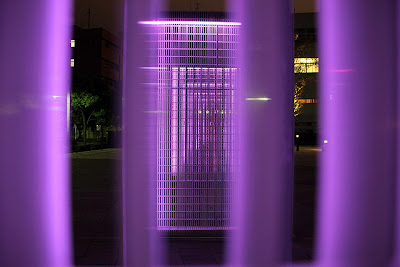From Bujinkan Santa Monica by Bujinkan Santa Monica
 |
| Purple Grid - Yokohama, Japan photo by OiMax |
In martial arts Iro 色 is something that can be observed. For example: the color of your face, color of your sword, color of your attack, color of your Kamae, etc. The opponent's attack or his desire to win is often times described as Iro.
I describe hearing Sensei refer to this on my blog post, Beyond Striking and Kiai Into the Mysteries of Toate No Jutsu:
I was at a Friday night class with Hatsumi Sensei in the Hombu Dojo when Soke described toate no jutsu as a kiai or projection of spirit (maybe 気迫 kihaku?). Sensei said it was like the color of your heart projecting into space. That color comes from your character or can be that which you decide to project. He said all this with his purple hair and made reference to Kabuki theatre in which a purple scarf on the head denotes death.The concept of Goshiki 五色 can be 5 colors. Usually we hear this word as 5 consciousnesses (Goshiki 五識). From the Great Buddhist Dictionary (仏教大辞典、小学館) we can learn the following:
"The five basic colors are Green, Yellow, Red, White and Black. They refer to the five Skandhas (goshiki 五識), the five Wisdoms (gochi 五知) or the five Buddhas (gobutsu 五佛) as an expression of the various Buddhist teachings.
In Japan there was the custom during the Heian period to hang a scroll of Buddha Amida Nyorai in front of a dying person, whith a fivecolored string (goshiki no ito 五色の糸) coming from the hand of the Buddha extending to the hands of the person. If you hold it firmly during your last minutes, you were assured a strait passage to the Paradise of the West (Amida Joodo 阿弥陀浄土).
One of the objects in the hand of a Kannon with 1000 Hands (Senju Kannon 千手観音) is a Fivecolored Cloud (goshikiun 五色雲).
The water poured over the head of the statue of Shakyamuni as a child during the festival for his birthday on April 8 (kanbutsu-e潅仏会) is called Fivecolored Water (goshikisui 五色水)."
You can also see these colors in 5 types of Daruma dolls, or Tibetan and Japanese prayer flags (goshiki ban 五色幡) .
These flag colors also represent the 5 elements:
Ku: Blue is the sky;
Fu: White is for the clouds;
Ka: Red is fire;
Sui: Green is water; and
Chi: Yellow is for the earth.
Each wave of the flag by the wind is considered one complete reading of the prayers printed on the flags.
On an ancient battle field, 5 colored flags were used for moving troops.
YELLOW shows the location of base camp or rally point.
When the other flags are raised:
BLUE: Frontline Troops will GO EAST
RED: Frontline Troops will GO SOUTH
WHITE: Frontline Troops will GO WEST
BLACK: Frontline Troops will GO NORTH
This is where we get the expression "色につき色にしたがふ" (attach to color, follow the color) and even though these ancient battle field strategies have been forgotten, the expression survives till this day in kenjutsu practice.
In a Japanese Shrine, you may find four animal flags in each direction:
East: Blue Dragon
West: White Tiger
South: Red Peacock
North: Black Turtle
So what about Hatsumi Sensei's purple hair? If you ask him you may not get the answer you expect. He told someone I know that it was to protect him from STD's (sexually transmitted diseases). For a straighter answer, here is what he told Doug Wilson: Smoke On The Water.
We can learn a lot about the color Murasaki 紫. In Feng Shui it symbolizes Yin, spiritual awareness, physical and mental healing. A purple Daruma (there are some!) is for a long life and preventing disasters. The pigment Murasaki is taken from the root of the plant with this name and in Japanese poetry it denotes perseverance.
Murasaki iro 紫色 also suggests high rank and leadership. In the ancient courts of Japan, there was The Twelve Level Cap and Rank System (冠位十二階 Kan'i Jūnikai), established in 603. The highest rank was assoiciated with the highest virtue. At the top was 大徳 Daitoku Greater Virtue and it was represented with purple.
紫の雲にいつ乗るにしの海
murasaki no kumo ni itsu noru nishi no umi
on purple clouds
when will I set sail?
western sea
-Issa



